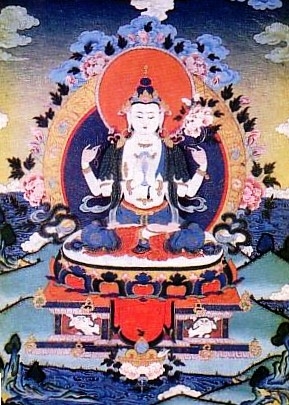Compassion: Difference between revisions
Jump to navigation
Jump to search
No edit summary |
No edit summary |
||
| Line 22: | Line 22: | ||
==Notes== | ==Notes== | ||
<small><references/></small> | <small><references/></small> | ||
==Further Reading== | |||
*Luis O. Gómez, 'Karuṇābhāvanā: Notes on the Meaning of Buddhist Compassion'. ''Tibet Journal'', vol. 3 no 2, pages 33-59. | |||
*Newland, Guy. ''Compassion, a Tibetan Analysis: A Buddhist Monastic Textbook''. Boston: Wisdom, 1985. | |||
[[Category:Key Terms]] | [[Category:Key Terms]] | ||
[[Category:Compassion]] | [[Category:Compassion]] | ||
[[Category:Prayers and Practices]] | [[Category:Prayers and Practices]] | ||
Revision as of 10:46, 1 November 2011

Compassion (Skt. karuṇā; Tib. nyingjé; Wyl. snying rje[1]) — one of the four immeasurables. It is defined as the wish that others may be free from suffering and its causes.
His Holiness the Dalai Lama says:
- "When I speak of ‘basic human feeling’, I refer to the capacity we all have to empathize with one another. This is what enables us to enter into the pain of others and, to some extent, participate in the pain of others.
- Our innate capacity for empathy is the source of that most precious of all human qualities, which in Tibetan we call nyingjé. The term nyingjé has a wealth of meaning that includes: love, affection, kindness, gentleness, generosity of spirit, and warm-heartedness. It does not imply pity; on the contrary, nyingjé denotes a feeling of connection with others. Also, it belongs to that category of emotions which have a more developed cognitive component. So we can understand nyingjé as a combination of empathy and reason.
- We can think of empathy as the characteristic of a very warm-hearted or well-meaning person; reason as that of someone who is very practical (and truly intelligent and wise). When the two are put together, the combination is highly effective."[2]
Subdivisions
- compassion focused on sentient beings,
- compassion focused on phenomena, and
- compassion without focus.
These distinctions are made purely in terms of focus (dmigs pa), whilst in all three cases the attitude of mind (rnam pa) is the same, i.e. the wish that there may be freedom from suffering. For more see three kinds of compassion
Oral Teachings on Compassion Given to the Rigpa Sangha
- Sogyal Rinpoche, Lerab Ling, 19 October 2009
Notes
Further Reading
- Luis O. Gómez, 'Karuṇābhāvanā: Notes on the Meaning of Buddhist Compassion'. Tibet Journal, vol. 3 no 2, pages 33-59.
- Newland, Guy. Compassion, a Tibetan Analysis: A Buddhist Monastic Textbook. Boston: Wisdom, 1985.